![]()
![]()
![]()
Use LEFT and RIGHT arrow keys to navigate between flashcards;
Use UP and DOWN arrow keys to flip the card;
H to show hint;
A reads text to speech;
48 Cards in this Set
- Front
- Back
|
Type 1 animal welfare concept |
Single attribute that can be directly measured |
|
|
Type 2 animal welfare concept |
Single attribute that cannot be measured directly but which can be estimated by combining contributing variables
example: measuring the weight of sun-bathers that would make a balcony collapse - need to objectively estimate design of structure, thickness of beams |
|
|
Type 3 animal welfare concept |
A trait involving multiple attributes linked by some commonality of function
example: measuring safety of a building - level of toxins in paint, fire escapes → common function is safety |
|
|
Why is animal welfare not a type 1 concept? |
For example, longevity:
-Single, measurable attribute
-Indirect indicator of quality of life (suggests most biological needs are met)
- BUT living longer does not mean a better quality of life (prisoners may live longer than owners of small aircraft)
|
|
|
Why is animal welfare not a type 2 concept? |
- Integrating various attributes - Can objectively measure things like stress, productivity, health, behaviour
- BUT: we do not know the objective correct weighting of the attributes |
|
|
Why is animal welfare a type 3 concept? |
- Different attributes measured objectively with common link (quality of life of animals)
- Interpretation of results involves values - Scientific findings will not eliminate value based differences
- Animal welfare cannot be measured directly only assessed in a manner similar to safety or health |
|
|
Animal Welfare definition (short): |
- How an animal copes with the conditions it lives in
- The state of the animal |
|
|
Stress |
Denotes a real or perceived perturbation to an organisms physiological homeostasis or phsycological well-being (NAC, 2008) |
|
|
Claude Bernard on stress |
1878 Maintenance of a constant internal state in a constantly changing external environment |
|
|
Walter Cannon on stress |
1929 -Termed 'homeostasis' - flight or fight response - sympatho-adrenal system |
|
|
Hans Selye on stress |
1950 - Generalized stress response - Hypothalamic-pituitary-adrenal response |
|
|
Moberg's definition of stress |
The biological response elicited when an individual perceives a threat to its homeostasis (2000)
|
|
|
What is a stressor |
A "threat" - includes external events or internal factors including pain |
|
|
Homeostasis |
The tendency of a system, especially the physiological system of higher animals, to maintain internal stability, owing to the coordinated response of its parts to any situation or stimulus that would tend to disturb its normal condition or function |
|
|
How are stress and distress different? |
A term that helps differentiate between a non-threatening stress response and a biological state where the stress response has a deleterious effect on the individual's welfare (Moberg, 2000)
i.e. stress may not be a bad thing, but once it turns to distress then it is a bad thing |
|
|
Carstens and Moberg definition of distress |
An aversive, negative state in which coping and adaptation processes fail to return an organism to physiological and/or psychological homeostasis (2000) |
|
|
Definition of Suffering |
Negative emotional state associated with distress: can be due to adverse physical or psychological circumstances and is moderated by the cognitive capacity and experiences of the individual (NHMRC, 2008)
- capacity for sentience and role of feelings and emotions in experience |
|
|
Model of stress and distress |
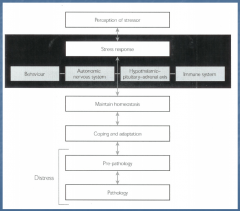
|
|
|
What are the 4 major biological responses to stress? |
- Behaviour - Neuroendocrine system - Autonomic nervous system - Immune system |
|
|
Behaviour as a biological response to stress |
- First line of defense - withdraw, fight or flight, freeze |
|
|
How is behaviour different in animals in response to stress? |
- Modified by species, environment, pain intensity, learning etc
- Variable response by same species to same stimulus (naive animal will be more stressed or animal with bad experiences will be more stressed)
- behaviour options can be limited in some environments |
|
|
2 major physiological indicators of stress |
Cortisol and Norepinephrine |
|
|
Autonomic nervous system as a biological response to stress |
- short term - fight or flight - quick physiological adjustment - learning and memory may be improved
|
|
|
How can we easily measure ANS response? |
It is very quick and difficult to measure
- one technique that has been used is to measure eye temperature: temp decreases then increases very quickly |
|
|
ANS Physiological response |
Hypothalamus → (direct neural connection with) Adrenal medulla (not cortex!)
Adrenal medulla:
- Increase in HR - Vessel dilation and constriction (these with HR redirect blood to flow to brain and skeletal muscle) - Facilitation of activation of other stress hormones (e.g. cortisol) - Stimulation of gluconeogenesis and lypolysis
|
|
|
Neuroendocrine system as biological response to stress |
HPA Axis = Hypothalamic-pituitary-adrenal
- long lasting effects on body - all biological functions affected by stress are regulated by pituitary hormones
|
|
|
Hormones related to stress: |
In response to stress, see increase in:
- cortisol - corticosterone - prolactin - somatotropin - thyroid stimulating hormone - gonadotropins (LH and FSH) |
|
|
Cortisol stress response pathway |
Based on blood flow, slower than ANS, easier to see response and measure it
Hypothalamus perceives a stress ↓ (CRF) corticotrophiin releasing factor) Anterior pituitary ↓ (ACTH) Adrenocorticotrophin hormone Adrenal (cortex) ↓ (cortisol) glucocorticoids Systemic tissues
|
|
|
What does increased Cortisol do in systemic tissues? |
Redirecting nutrients: - Inhibition of gonadotrophins (reproduction) - Suppression of growth hormone (growth) - enhanced glucose production for immediate needs
Preventing autoimmunity: - suppression of T-cell activity (immune function) |
|
|
Issues with measuring cortisol levels: |
How much of a rise in cortisol is important? Is the animal actually in distress (vs stress)?
Is the response disrupting normal processes? Is the response effective? |
|
|
Immune system as a biological response to stress |
- modified by other systems (HPA)
- cytokines communicate between nervous system and immune system
- can measure immune competence to look at disease components of stress |
|
|
Short term stress vs Prolonged stress |
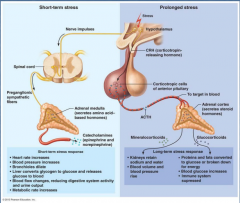
|
|
|
Challenges to measuring stress: |
- Experiments actually require you to stress the animals
- All 4 systems used in response to stress but not all used to defend homeostasis
- different stressors elicit different types of biological responses
- need specific measures for each stressor for each system |
|
|
Moberg's greatest challenge to measuring stress: |
Interanimal variation in the stress response is the greatest problem in measuring stress (Moberg, 1985)
System used, and to what extent, is influenced by a variety of factors or modifiers |
|
|
Modifiers of stress response |
Experience Genetics Age Physiological state Season |
|
|
Stress pathway with Modifiers |
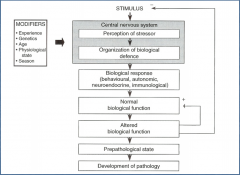
|
|
|
So what should we focus on when trying to measure stress? |
Changes in biological function
How biological defenses impact the animal |
|
|
When does stress become a threat? |
"Stress becomes a threat only when the stress response is of such a magnitude that... it is sufficient to endanger the general well-being of the animal" (Moberg, 1985) |
|
|
Animal Welfare vs. Stress level graph |
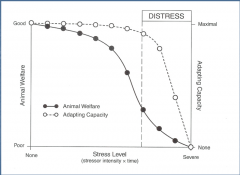
If an animal has mechanisms available to deal with the stress (can adapt), it is okay.
Once it cannot cope, it is in distress |
|
|
Moberg's stress model |
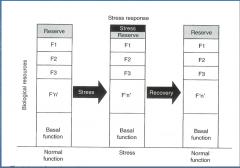
Animal has a reserve of energy to deal with stress
Stress will decrease that reserve
Recovers to having a full reserve |
|
|
Moberg's distress model |
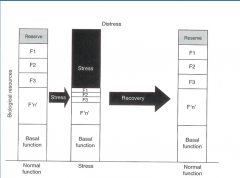
Insufficient reserves to deal with the stress = shift resources away from other biological functions such as growth or reproduction
Animal has entered prepathological-pathological state and are experiencing distress |
|
|
Acute distress vs Chronic distress |
Acute: - short duration with large biological costs (e.g. disrupt ovulation or retards growth)
Chronic: - same acute stressor over time (environment, heat, cold) - summation of several stressors |
|
|
Summation of a stressor |
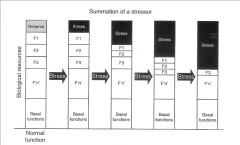
|
|
|
Summation of multiple stressors |
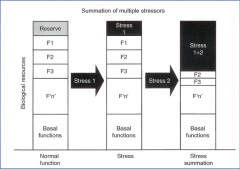
example: calf being weaned and being moved to a new property |
|
|
Subclinical Stressors |
A type of chronic stress - by itself does not effect function, but makes you vulnerable to effects of another stressor (it is an underlying stress)
example: getting sick during exams
|
|
|
Threat of subclinical stress graph |

|
|
|
Potential stressors associated with traditional weaning of calves |
1. age at weaning is younger than natural age 2. new social environment - absence of adults - mixing of unfamiliar animals - formation of new social hierarchy 3. physical separation of mother and calf 4. premature end of lactation (even though milk is still available) 5. transportation 6. new location 7. new diet
(Stookey, 2011) |
|
|
How does weaning negatively affect calves? |
- Creates immuno-compromised individuals - More calves treated for disease and health issues immediately post-weaning than any other time - Visible and overt signs of distress that last 3-5 days - noticeable set back in performance (shutting down of growth hormone response) |

